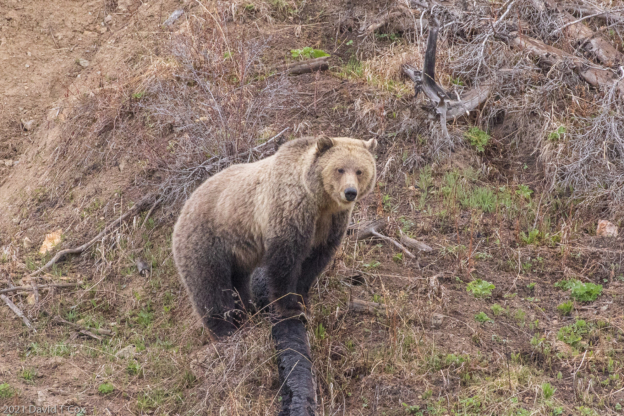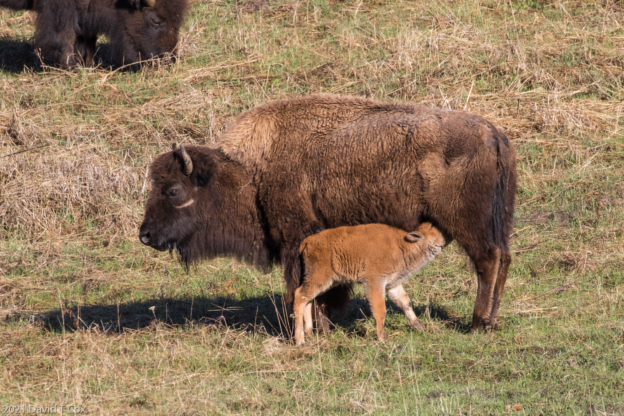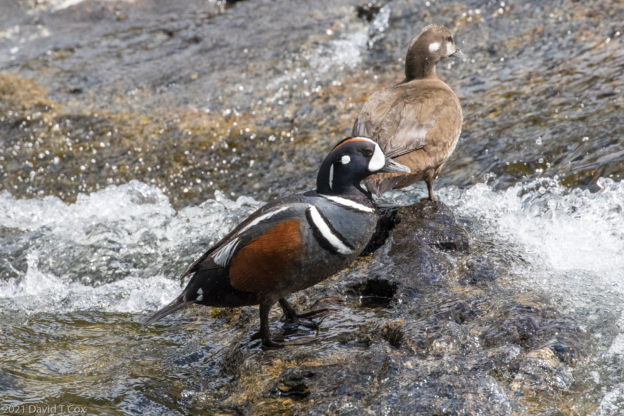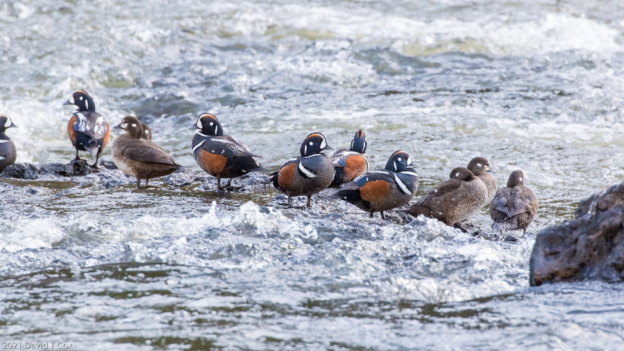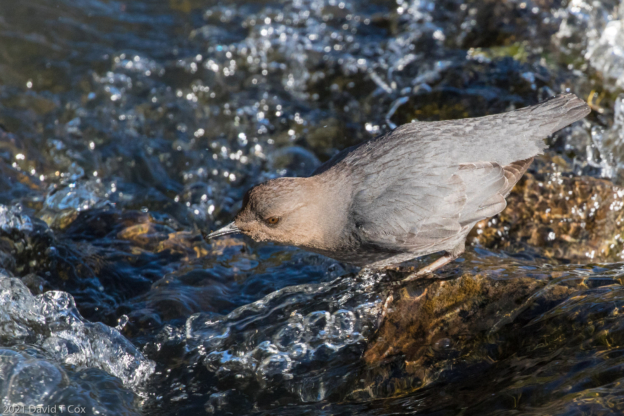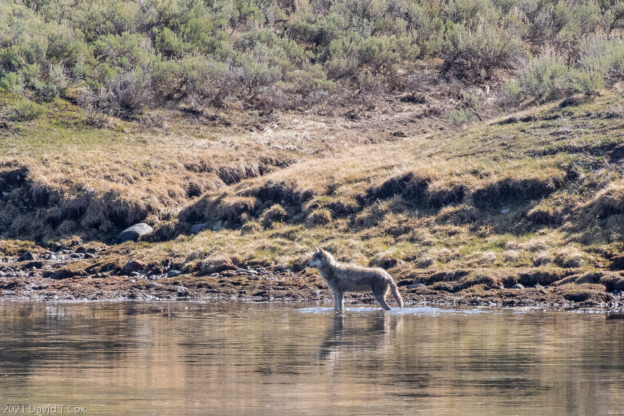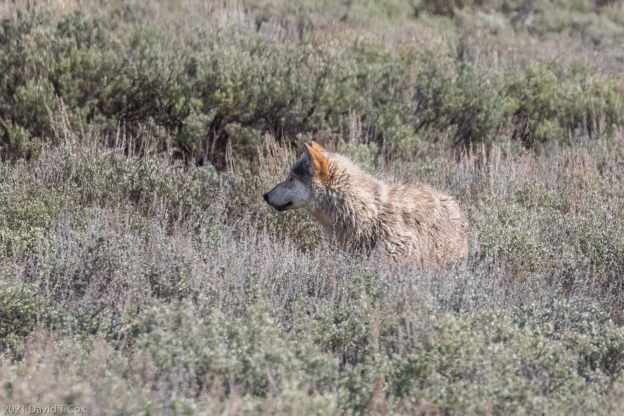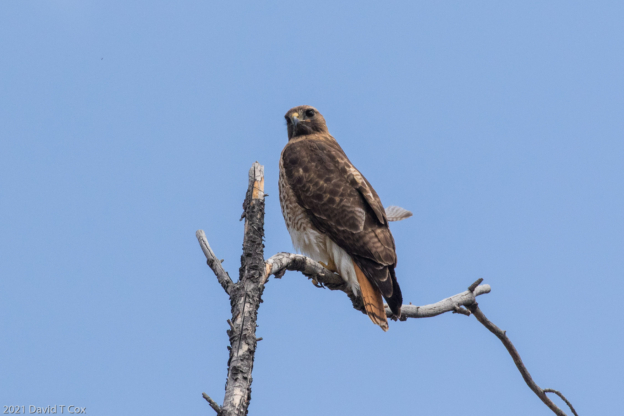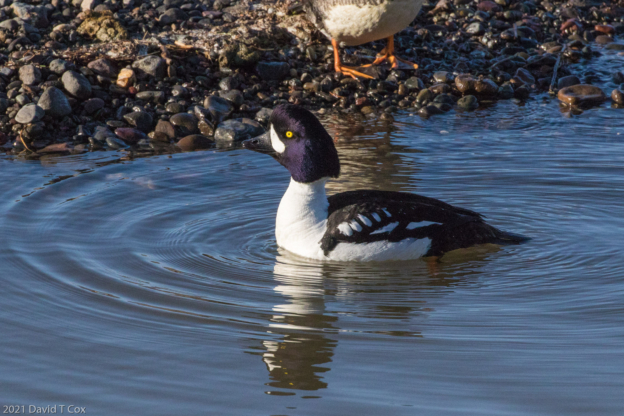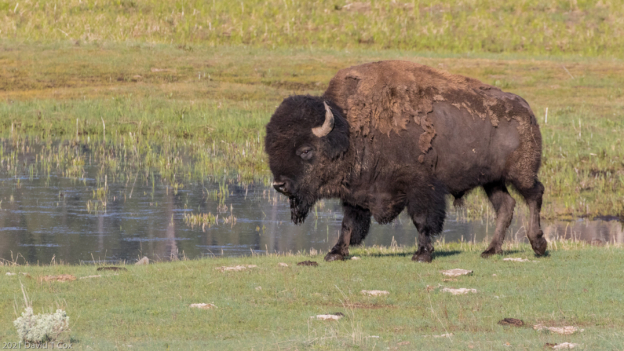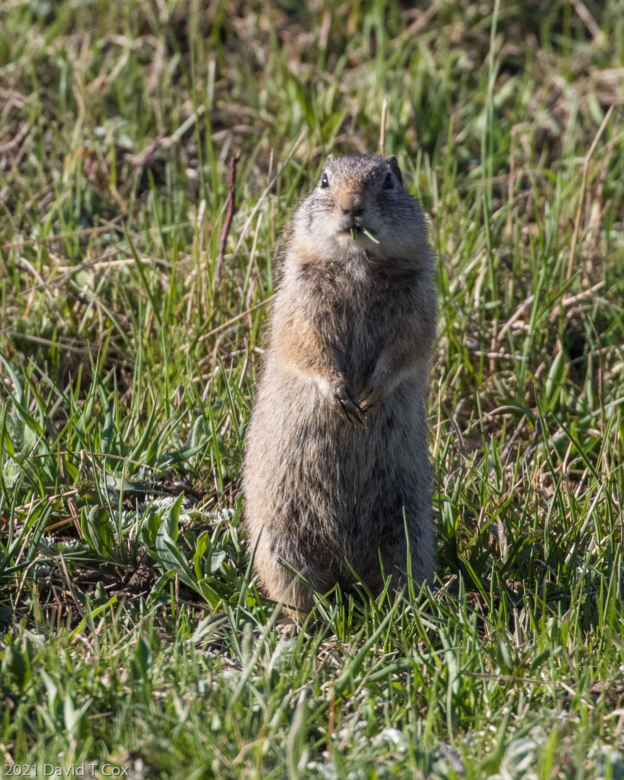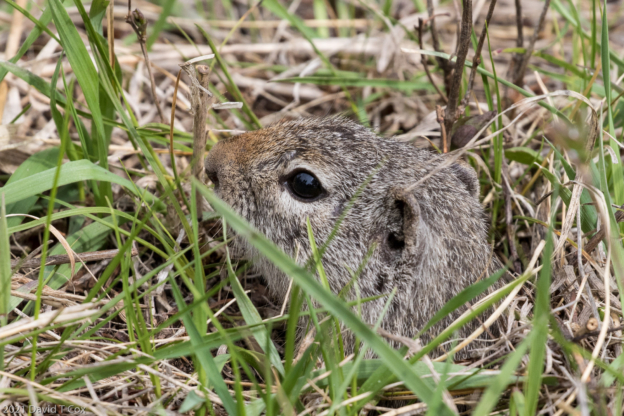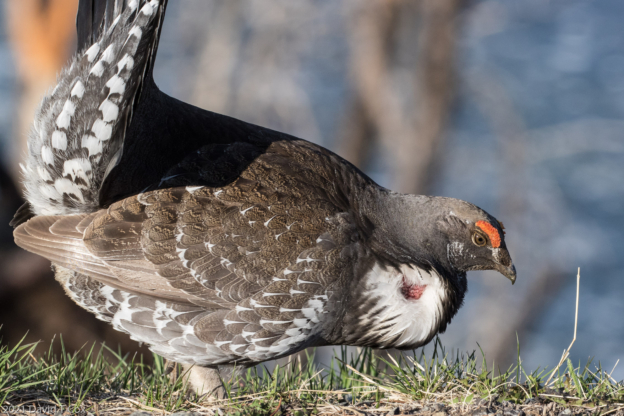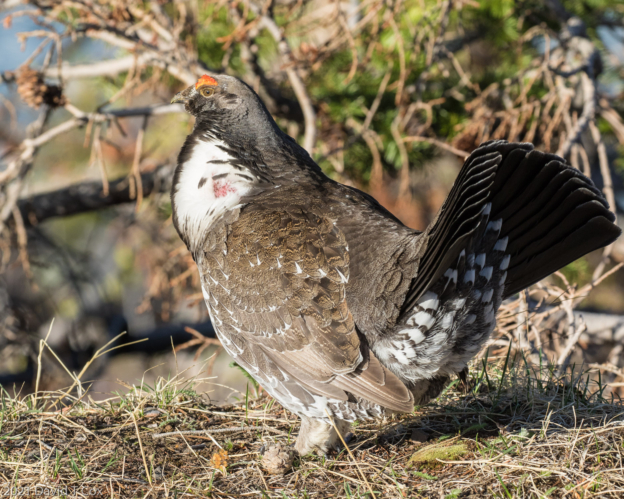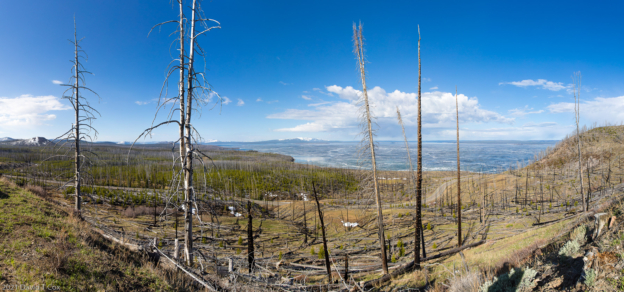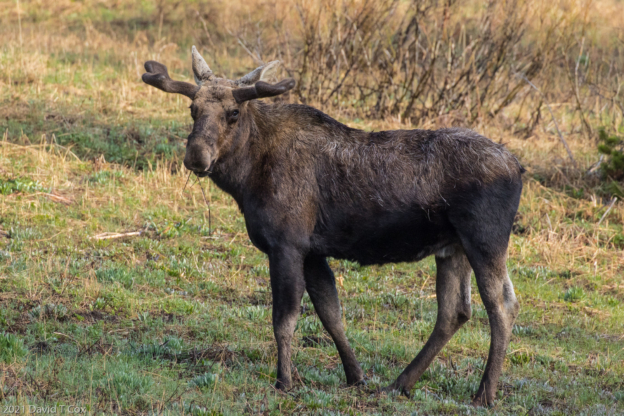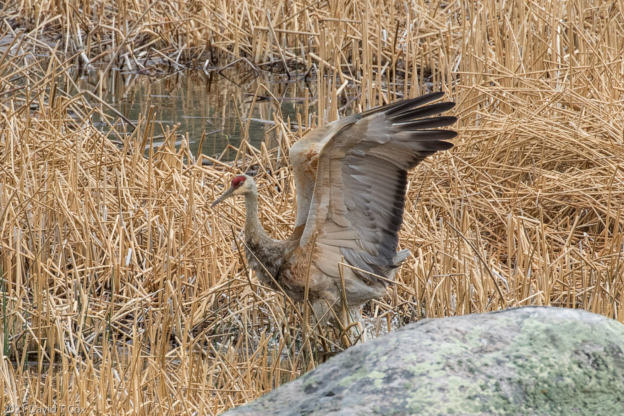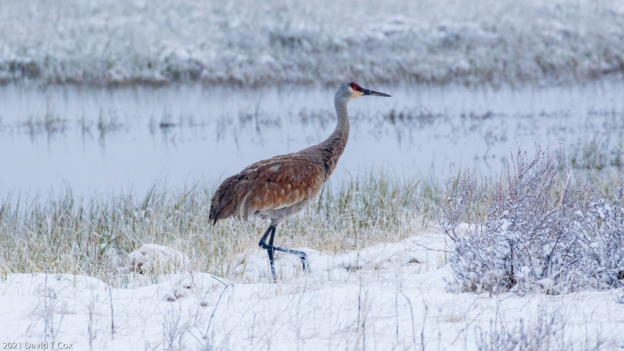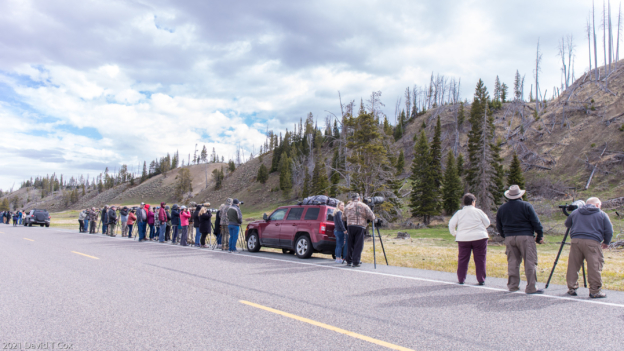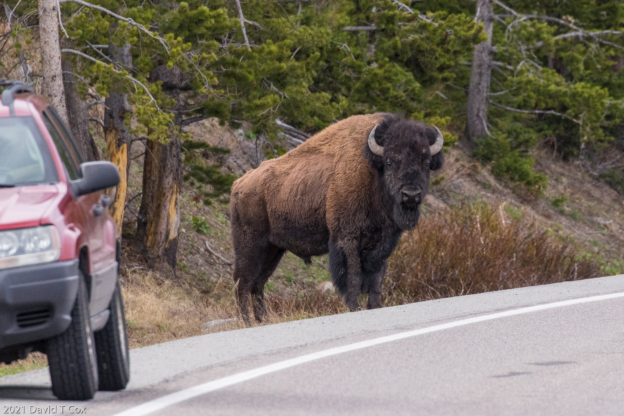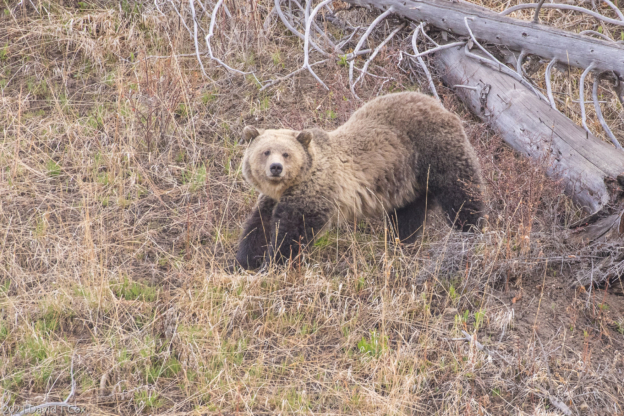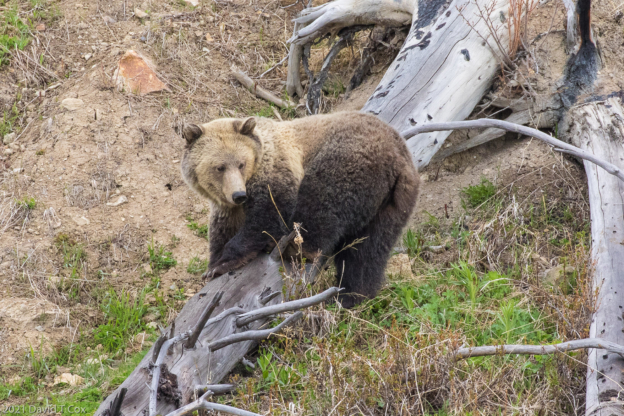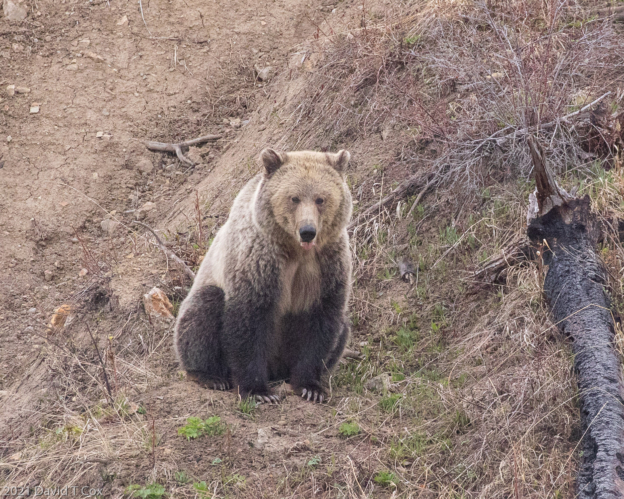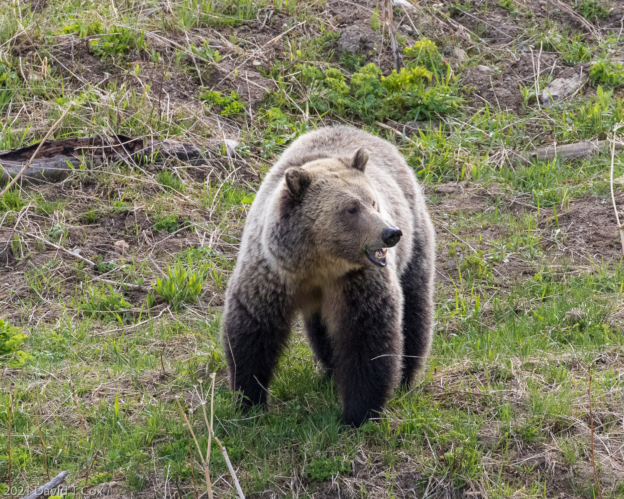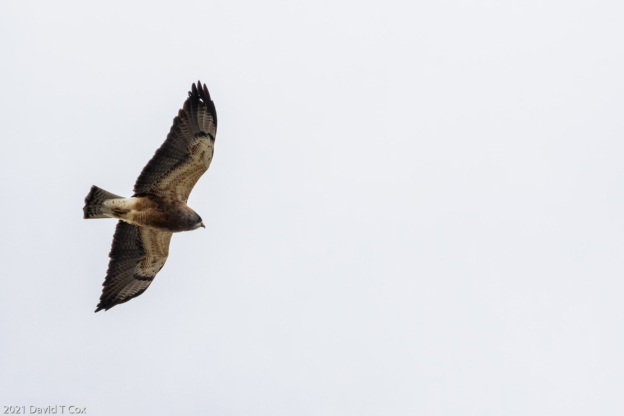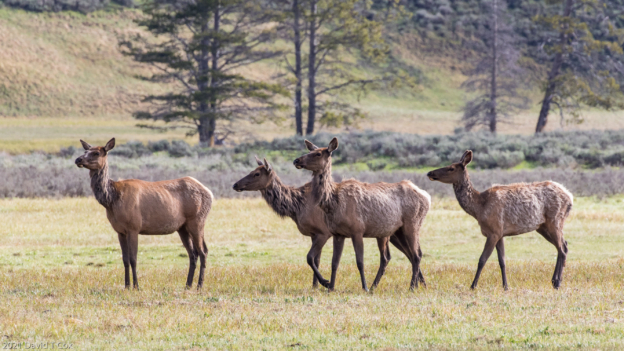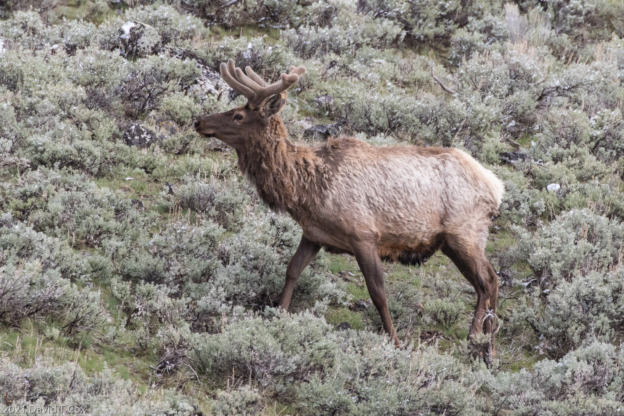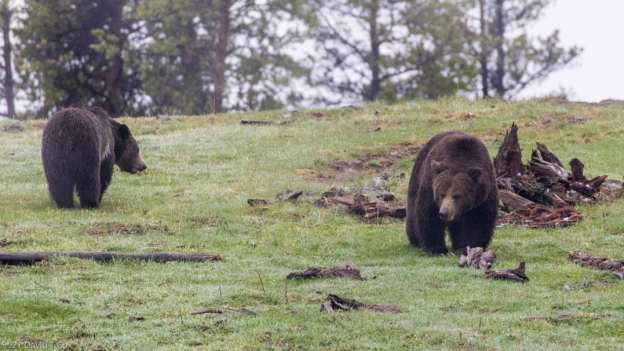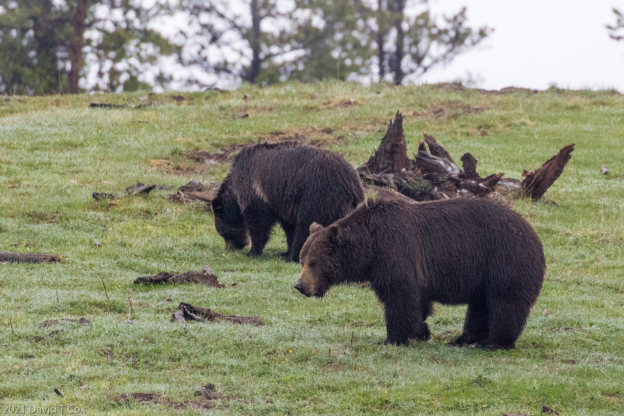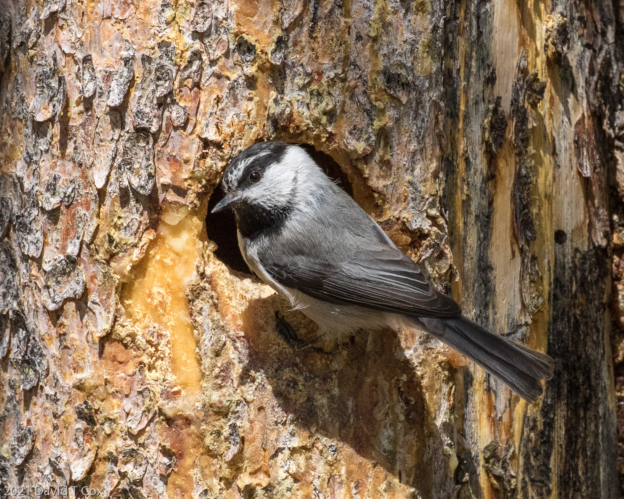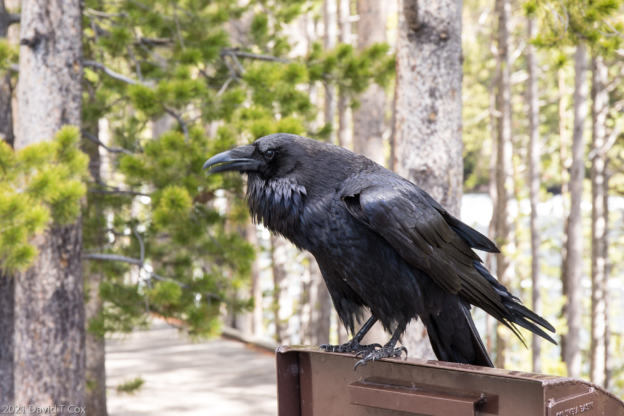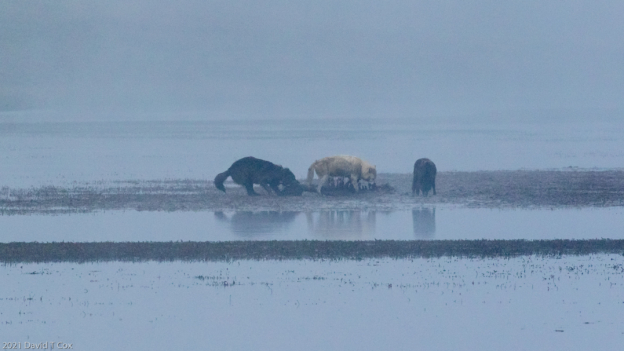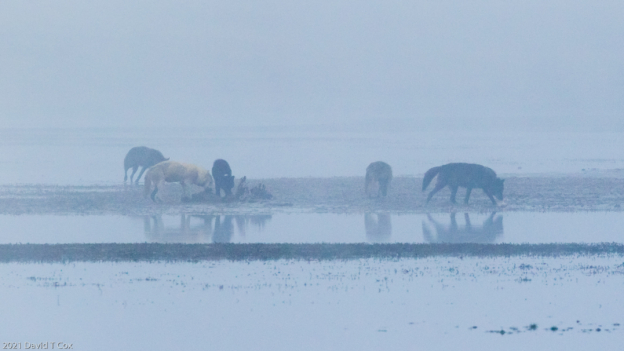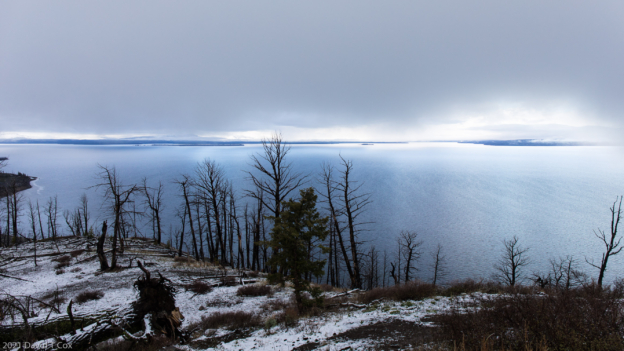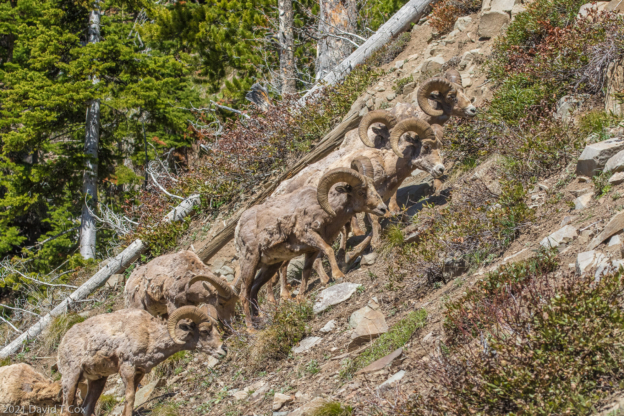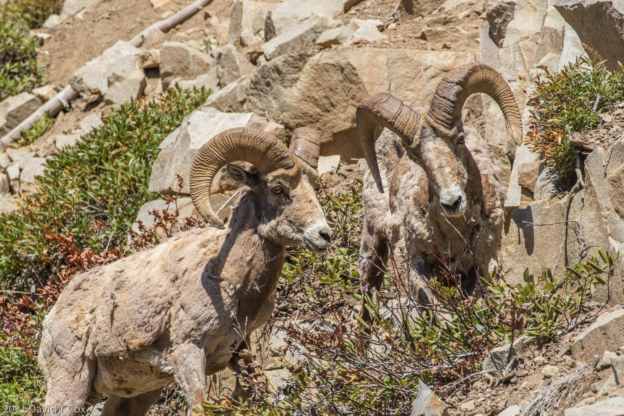All Photos Are Below the Travelogue Text
Click on Any Photo To Open Slide Show
To print the travelogue, right click anywhere on the page. Choose "Print" from your browser dialog box. You can choose Save to PDF in the browser print window.
Share your thoughts.
Email Dave - coxdavid55@hotmail.com
I last posted from Billings, MT. I drove up the Yellowstone River to Livingston, the original RR line junction which opened up Yellowstone over 100 years ago. From there I continued following the Yellowstone River south to Gardiner, MT, which sits at the Northern entrance to the Park. Spending 8 days in Gardiner, I spent about double normal price for a room in the Big Rock Hotel. Elk doe grazed on the grass outside my room. I could not extend my stay in Gardiner after 8 days, so moved to West Yellowstone for an additional 6 days, where the small motel room was even more expensive.
Daily I departed my room at 5 am to travel either into Lamar Valley or Hayden Valley, generally arriving at sunrise, about 6 am. Close to half of the days saw heavy rain, snow or ice storms, with wind – on one day the Park Service was shutting down all roads at each junction as I cleared them. As in the past, I found I was joined in the early mornings by just a couple of dozen or so professional photographers and “wolf chasers”. Generally we had 3 hours to ourselves – then about 9 in the morning regular visitors and RVs would start to show up on the roads. By 10 am the roads would become crowded and by noon there were huge traffic jams, and parking at all tourist sites would be overflow. Every day, upon leaving the Park down the Madison River to West Yellowstone, I would pass cars going into the Park stopping in the middle of the road to take photos out the window of the first bison they had seen. As over half the cars did this, I started measuring the length of the traffic jams behind the bison. On two days I measured just over 5 miles of traffic jam, and then on my last day exiting this route, the start of Memorial Day weekend, the traffic jam ran all the way from Madison Junction to the entrance at West Yellowstone – exactly 14 miles. These people would take 1 to 2 hours to just reach the first junction getting into the Park.
Lamar Valley contains probably the largest concentration of American Bison in existence; total numbers in the Park range from 3,500 to 5,000 animals – these are not re-introduced nor mixed blood, but direct descendants of the remaining original bison which in the great plains once numbered in the millions. Both valleys also are the hunting ranges and den locations of the two most visible wolf packs, which generally prefer elk, but will take young or frail bison.
I averaged 7 hours a day over a total of 15 days inside the Park. A great deal of the time was seeking relatively close encounters with grizzly bear and wolves, the highlights for wildlife photography in the area (most wolf and grizzly sightings are at around a mile distant, and although interesting to watch through a spotting scope, are not amenable to photography; decent photos require getting close, though the Park mandates a 100 yard limit, so large telephoto is mandatory). I managed to photograph 2 different grizzly encounters – the first with the wonderful antics of a 7 year old “blond” female which the biologists had nicknamed “Snow” due to its light coloration. For two hours, between bouts of eating, she preened, sat like a dog, contorted to scratch, snoozed with a log for a pillow, stretched and balanced on logs. With about 25 other photographers (see photo), we lined the road for almost 2 hours enjoying the show, except for a brief encounter with a bull bison which wanted to pass through. The second encounter was with a very dark, huge, male and female turning stones and grazing some plants on a mountain side. These two looked far more menacing than Snow. The Park’s first grizzly mauling of the year took place just two days ago on a trail a couple of miles from Gardiner where I spent my first 8 days. The hiker survived, but no more details on the attack were available.
Wolves can be seen often near their respective dens in the spring. If the weather is nice, the pups come out to play – I have included no photos as the dens are more than a mile from where visitors may go. I did spend over 2 hours on a frigid early morning watching 5 wolves from the Hayden Valley pack devour an elk kill in very heavy fog – it made for some interesting photos. I also watched a lone young wolf wind its way up and down the banks of the Yellowstone River, apparently trying to catch trout, and going after one Mallard duck, all without success.
As usual I found lots of elk and, in one small corner of the Park (above Pebble Creek), moose. The bulls of both species are just starting to grow their giant antlers, now stubby and still very much covered in velvet. The Rocky Mountain Bighorn Sheep, not often encountered, all look very ratty as they are losing big chunks of their winter coats. A band of males feeding on an almost impossibly steep mountain slope made for some unique photos. I also visited the Le Hardy Rapids on the Yellowstone where in mid-May the Harlequin Ducks do their diving and amazing maneuvering in fully boiling rapids (these ducks are quite rare to see except in far northern coastal waters). The male Harlequins are one of the most striking of birds. Other uncommon birds are the American Dipper, the only songbird that dives and flies under water for its food, and the Barrow’s Goldeneye, photos of both of which are included. I also lucked into a close-up session with a male Dusky Grouse doing a full blown mating display, with bared-breast spots and drumming, hoping to attract females. I am fortunate in being able to annually visit and photograph almost the entire population of Sandhill Cranes in existence, as they all winter in a single spot in Southern Arizona. However, for the spring and summer they migrate to spread across the northern US and southern Canada for breeding. In Yellowstone I got to photograph a female at her nest and an adult in breeding colors in the frozen snow. Finally, the Park is the home of huge numbers of Ravens – many have learned to acquire food from bear-proof trash containers – I have included a photo of a particularly handsome one getting ready to dine.
I drove yesterday to Cody outside the East entrance to the Park. I will stay here a few days to catch up on some chores, and then have reserved a room in DuBois, WY, heading up the Wind River Range on the Continental Divide with the highest mountains in the state (and some of the highest in the continental US). This range provides the most remote headwaters of two major river systems – the Yellowstone which runs North completely across the Park and ultimately into the Missouri and Mississippi to drain into the Atlantic, and the Snake which runs southwest, then north and west to join the Columbia River to drain into the Pacific. I probably next will head basically South towards home. I have been reviewing online a completely new set of Canon professional camera bodies and long lenses which would significantly improve my capture distance for wildlife photos, permit lower light capture while simultaneously reducing my carrying weight – in all, a seemingly impossible dream a few years ago. I, of course, suddenly feel the need to own this new equipment before taking further photos.
Later, Dave
- Lamar Valley pano, Yellowstone NP, WY
- Bison calf suckling, Lamar Valley, Yellowstone NP, WY
- Harlequin Duck, Haydn Valley, Yellowstone NP, WY
- Harlequin Duck, Haydn Valley, Yellowstone NP, WY
- American Dipper, Haydn Valley, Yellowstone NP, WY
- Grey Wolf, Haydn Valley, Yellowstone NP, WY
- Grey Wolf, Haydn Valley, Yellowstone NP, WY
- Red-tailed Hawk, S of Gardiner, MT
- Barrow’s Goldeneye, Junction Soda Butte Creek into Lamar River, Yellowstone NP, WY
- Bison, Lamar Valley, Yellowstone NP, WY
- Belding Ground Squirrel, Lamar Valley, Yellowstone NP, WY
- Belding’s Ground Squirrel exiting brood tunnel, Lamar Valley, Yellowstone NP, WY
- Dusky Grouse male “booming” (fka Blue), Lake Butte Overlook, Yellowstone NP, WY
- Dusky Grouse male “booming” (fka Blue), Lake Butte Overlook, Yellowstone NP, WY
- Yellowstone Lake pano, from Lake Lookout, Yellowstone NP, WY
- Bull Moose w Spring antlers, Soda Butte Creek, Yellowstone NP, WY
- Sandhill Crane at nesting site, Lamar Valley, Yellowstone NP, WY
- Bighorn Sheep ewes shedding winter coats, Lamar Valley, Yellowstone NP, WY
- Sandhill Crane on snowy dawn, Rd from Mammoth to Norris, Yellowstone NP, WY
- Grizzly Bear (Snow 6 yrs old), entrance Rd N or Lake, Yellowstone NP, WY
- spectators watching Grizzly Bear (Snow 6 yrs old), entrance Rd N or Lake, Yellowstone NP, WY
- Bison approaching crowd watching Grizzly Bear, entrance Rd N or Lake, Yellowstone NP, WY
- Grizzly Bear (Snow 6 yrs old), entrance Rd N or Lake, Yellowstone NP, WY
- Grizzly Bear (Snow 6 yrs old), entrance Rd N or Lake, Yellowstone NP, WY
- Grizzly Bear (Snow 6 yrs old), entrance Rd N or Lake, Yellowstone NP, WY
- Grizzly Bear (Snow 6 yrs old), entrance Rd N or Lake, Yellowstone NP, WY
- Swainson’s Hawk, Hayden Valley, Yellowstone NP, WY
- Elk, near Fishing Bridge junction, Yellowstone NP, WY
- bull Elk w Spring antlers, Lamar Valley, Yellowstone NP, WY
- Bison in snow, Hayden Valley, Yellowstone NP, WY
- Grizzly Bear, Hayden Valley by Sulfur Cauldren, Yellowstone NP, WY
- Grizzly Bear, Hayden Valley by Sulfur Cauldren, Yellowstone NP, WY
- Mountain Chickadee at nest hole, Madison River, Yellowstone NP, WY
- Common Raven, LeHardy Rapids, Hayden Valley, Yellowstone NP, WY
- Grey Wolves on Elk kill in dense fog, Hayden Valley, Yellowstone NP, WY
- Grey Wolves on Elk kill in dense fog, Hayden Valley, Yellowstone NP, WY
- Yellowstone Lake from Lake Butte Overlook on foggy dawn, Yellowstone NP, WY
- Rocky Mtn Bighorn Sheep males – shedding winter coats, just E of Sylvan Pass, Yellowstone NP, WY
- Rocky Mtn Bighorn Sheep males – shedding winter coats, just E of Sylvan Pass, Yellowstone NP, WY
To print the travelogue, right click anywhere on the page. Choose "Print" from your browser dialog box. You can choose Save to PDF in the browser print window.
Share your thoughts.
Email Dave - coxdavid55@hotmail.com
